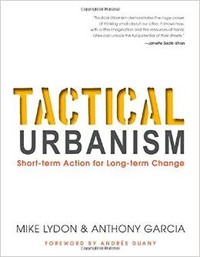A New Book on Tactical Urbanism by Mike Lydon and Anthony Garcia - CityLab
Source: A New Book on Tactical Urbanism by Mike Lydon and Anthony Garcia &8211; CityLab

Now the movement has its own glossy print book, Tactical Urbanism: Short-Term Action for Long-Term Change, just out from Island Press. Co-authored by Mike Lydon and Anthony Garcia, who are partners in a firm called the Street Plans Collaborative, the book is a how-to guide that explains what tactical urbanism is and how it can create positive change in cities of any size. The book also acknowledges what tactical urbanism isn’t: namely, a solution to every problem.“It can’t solve the affordable housing crisis facing our most desirable cities, nor will it fix bridges in need of repair,” the authors write. “It can’t build high-speed rail lines, and it won’t resolve the looming public sector pension crisis found in so many North American cities.”What tactical urbanism can do, says Lydon, is loosen up the planning process and increase the flow of communication between citizens and government. “It’s about creating a different kind of process and bringing new ideas to people in a way that’s less threatening,” he says. “How do we expand the dialogue over the course of one week or one month?”Tactical urbanism projects can also scale up, says Lydon, without losing their connection to the neighborhoods that spawned them—a connection that is a vital condition of long-term success.The book includes five case studies of successful tactical urbanism projects from around North America. One of these happened in Hamilton, Ontario, where community members concerned about traffic safety brought Street Plans to town to lead a tactical urbanism workshop. After discussing their options and their budget, the community members did a nighttime installation of traffic cones as part of a DIY “intersection repair” at a corner where they thought traffic posed a threat to pedestrians, especially children.
The move, which created more space for people crossing the intersection on foot, led to immediate pushback from the city, which deemed the changes “illegal, potentially unsafe and adding to the City’s cost of maintenance and repair.” But then something funny happened: when a local community organization stepped forward to take responsibility for the action, the city listened to what its members had to say. Before long, Hamilton officials made the changes permanent, part of a sanctioned pilot program that has subsequently made similar modifications to more than 70 intersections around the city.Of course, not all tactical urbanist efforts have such happy endings. A willingness to fail, in fact, is a central tenet of the philosophy. And because so many of the measures that fall under the tactical urbanism umbrella are relatively cheap and easily reversed, failure is not a catastrophe, but rather a chance to learn. That kind of flexibility is crucial, Lydon says, in urban environments that are constantly changing. While tactical urbanism can’t replace old-fashioned large-scale planning, he says, it can inform a city’s broader approach to its citizens and its infrastructure.“The field of planning is always about the solution—we’re going to solve this and the we’re going to walk away and it’s going to be fine,” says Lydon. “But you need an overall process that’s going to respond to the fact that cities are dynamic. You need a process that recognizes it has to be responsive to the set of conditions that are present in that moment. What works now in a neighborhood might not work five years from now. It has to be fluid.”
